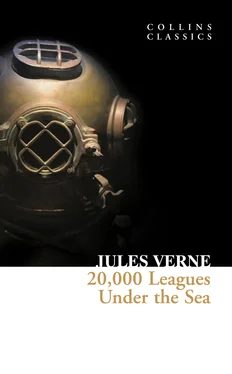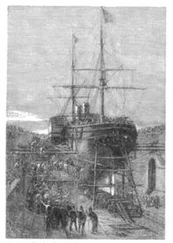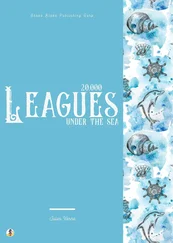These accounts arrived one after another; fresh observations made on board the transatlantic ship Le Pereire , the running foul of the monster by the Etna , of the Inman Line; a report drawn up by the officers of the French frigate La Normandie ; a very grave statement made by the ship’s officers of the Commodore Fitz James on board the Lord Clyde , deeply stirred public opinion. In light-hearted countries jokes were made on the subject; but in grave and practical countries like England, America, and Germany, much attention was paid to it.
In all the great centres the monster became the fashion; it was sung about in the cafés, scoffed at in the newspapers, and represented at all the theatres. It gave opportunity for hoaxes of every description. In all newspapers short of copy imaginary beings reappeared, from the white whale, the terrible ‘Moby Dick’ of the Northern regions, to the inordinate ‘kraken,’ whose tentacles could fold round a vessel of 500 tons burden and drag it down to the depths of the ocean. The accounts of ancient times were reproduced: the opinions of Aristotle and Pliny, who admitted the existence of these monsters, and the Norwegian tales about Bishop Pontoppidan, those of Paul Heggede, and lastly the report of Mr Harrington, whose good faith could not be put in question when he affirmed that, being on board the Castillian , in 1857, he saw this enormous serpent, which until then had only frequented the seas of the old Constitutionnel newspaper.
Then broke out the interminable polemics of believers and disbelievers in learned societies and scientific journals. The ‘question of the monster’ inflamed all minds. The journalists who professed to be scientific, at strife with those who professed to be witty, poured out streams of ink during this memorable controversy; some even two or three drops of blood, for they wandered from the sea serpent to the most offensive personalities.
During the first months of the year 1867 the question seemed to be buried out of sight and mind, when fresh facts brought it again before the public. It had then changed from a scientific problem to be solved to a real and serious danger to be avoided. The question took another phase. The monster again became an island or rock. On the 5th of March, 1867, the Moravian , of the Montreal Ocean Company, struck her starboard quarter on a rock which no chart gave in that point. She was then going at the rate of thirteen knots under the combined efforts of the wind and her 400 horse-power. Had it not been for the more than ordinary strength of the hull in the Moravian she would have been broken by the shock, and have gone down with 237 passengers.
The accident happened about daybreak. The officers on watch hurried aft, and looked at the sea with the most scrupulous attention. They saw nothing except what looked like a strong eddy, three cables’ length off, as if the waves had been violently agitated. The bearings of the place were taken exactly, and the Moravian went on her way without apparent damage. Had she struck on a submarine rock or some enormous fragment of wreck? They could not find out, but during the examination made of the ship’s bottom when under repair, it was found that part of her keel was broken.
This fact, extremely grave in itself, would perhaps have been forgotten, like so many others, if three weeks afterwards it had not happened again under identical circumstances, only, thanks to the nationality of the ship that was this time victim of the shock, and the reputation of the company to which the vessel belonged, the circumstance was immensely commented upon.
On the 13th of April, 1867, with a smooth sea and favourable breeze, the Cunard steamer Scotia was going at the rate of thirteen knots an hour under the pressure of her 1000 horse-power.
At 4.17 p.m., as the passengers were assembled at dinner in the great saloon, a slight shock was felt on the hull of the Scotia , on her quarter a little aft of the paddle.
The Scotia had not struck anything, but had been struck by some sharp and penetrating rather than blunt surface. The shock was so slight that no one on board would have been uneasy at it had it not been for the carpenter’s watch, who rushed upon deck, calling out – ‘She is sinking! she is sinking!’
Captain Anderson went down immediately into the hold and found that a leak had sprung in the fifth compartment, and the sea was rushing in rapidly. Happily there were no boilers in this compartment, or the fires would have been at once put out. Captain Anderson ordered the engines to be immediately stopped, and one of the sailors dived to ascertain the extent of the damage. Some minutes after it was ascertained that there was a large hole about two yards in diameter in the ship’s bottom. Such a leak could not be stopped, and the Scotia , with her paddles half submerged, was obliged to continue her voyage. She was then 300 miles from Cape Clear, and after three days’ delay, which caused great anxiety in Liverpool, she entered the company’s docks.
The engineers then proceeded to examine her in the dry dock, where she had been placed. They could scarcely believe their eyes; at two yards and a half below water-mark was a regular rent in the shape of an isosceles triangle. The place where the piece had been taken out of the iron plates was so sharply defined that it could not have been done more neatly by a punch. The perforating instrument that had done the work was of no common stamp, for after having been driven with prodigious force, and piercing an iron plate one and three eighths of an inch thick, it had been withdrawn by some wonderful retrograde movement.
Such was the last fact, and it again awakened public opinion on the subject. After that all maritime disasters not satisfactorily accounted for were put down to the account of the monster. All the responsibility of the numerous wrecks annually recorded at Lloyd’s was laid to the charge of this fantastic animal, and thanks to the ‘monster,’ communication between the two continents became more and more difficult; the public loudly demanding that the seas should be rid of the formidable cetacean at any price.
CHAPTER 2 For and Against
At the period when these events were happening I was returning from a scientific expedition into the region of Nebraska. In my quality of Assistant Professor in the Paris Museum of Natural History, the French Government had attached me to that expedition. I arrived at New York, loaded with precious collections made during six months in Nebraska, at the end of March. My departure from France was fixed for the beginning of May. Whilst I waited and was occupying myself with classifying my mineralogical, botanical, and zoological riches, the incident happened to the Scotia .
I was perfectly acquainted with the subject which was the question of the day, and it would have been strange had I not been. I had repeatedly read all the American and European papers without being any the wiser as to the cause. The mystery puzzled me, and I hesitated to form any conclusion.
When I arrived at New York the subject was hot. The hypothesis of a floating island or reef, which was supported by incompetent opinion, was quite abandoned, for unless the shoal had a machine in its stomach, how could it change its position with such marvellous rapidity? For the same reason the idea of a floating hull or gigantic wreck was given up.
There remained, therefore, two possible solutions of the enigma which created two distinct parties; one was that the object was a colossal monster, the other that it was a submarine vessel of enormous motive power. This last hypothesis, which, after all, was admissible, could not stand against inquiries made in the two hemispheres. It was hardly probable that a private individual should possess such a machine. Where and when had he caused it to be built, and how could he have kept its construction secret? Certainly a Government might possess such a destructive engine, and it was possible in these disastrous times, when the power of weapons of war has been multiplied, that, without the knowledge of others, a state might possess so formidable a weapon. After the chassepots came the torpedoes, and after the torpedoes the submarine rams, and after them – the reaction. At least, I hope so.
Читать дальше












